




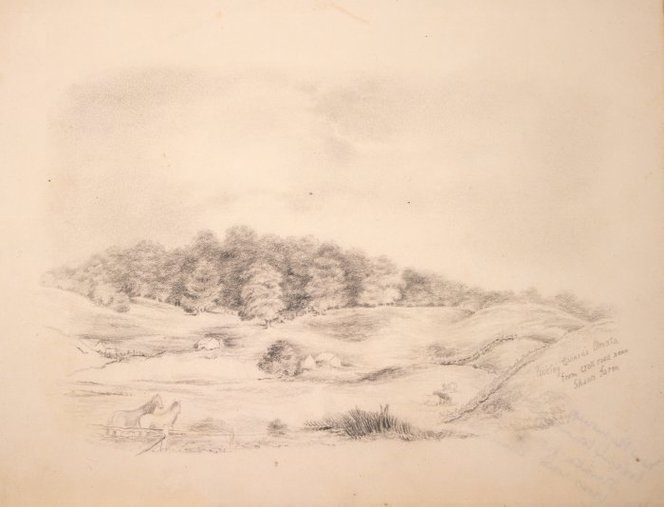
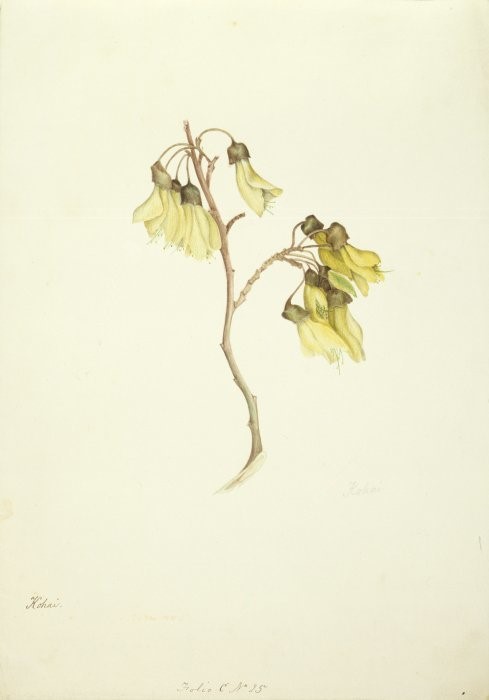
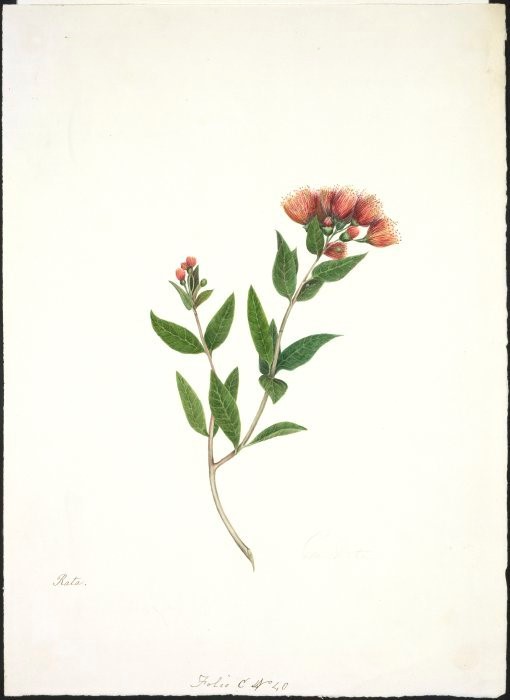
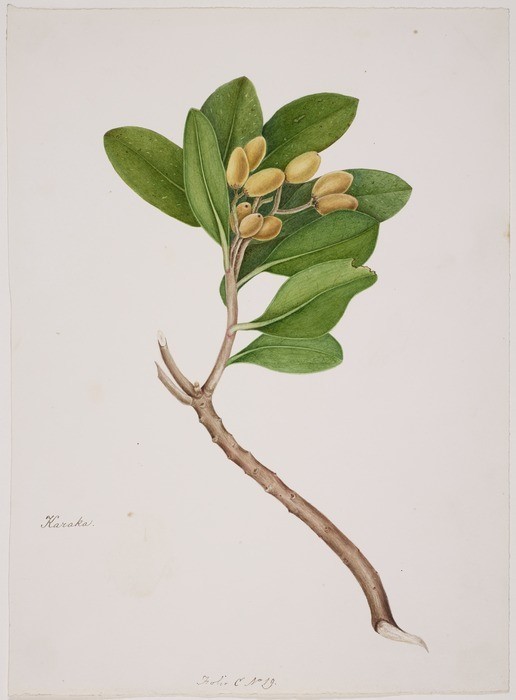
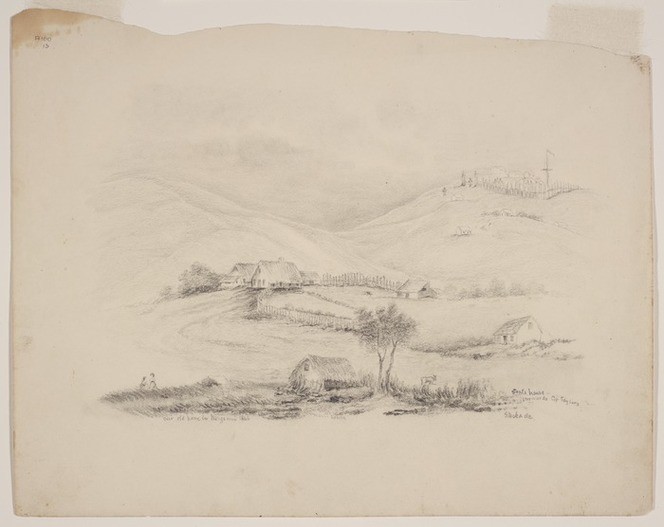
Martha King was a teacher first, painter second and gardener third. Born in Ireland around 1802, she arrived in Wellington in 1840 with sister Maria and brother Samuel. The King’s shared a cabin with the Wicksteed family and their friendship would last a lifetime.
In 1841, the King’s settled in Whanganui where they bought a section of land through Colonel William Wakefield of the New Zealand Company. During their first year, the family lived in tents and then in two raupō dwellings. The sisters opened the first school in the area. Maria Place, named after Martha's elder sister, now marks the site.
The school and the teachers, particularly Maria, became very popular, as shown by letters written by Whanganui resident Mrs Jessie Campbell to her family in Scotland: “We are so fortunate to have them [the children] all at school here and making good progress; they are taught by Miss King, an Irish lady, who came here with her brother.
“She is an old maid and very capable of doing them justice. Her method is excellent, she is so kind and at the same time, determined.
“Miss King takes great pains to give them general information and to give them a taste for reading...She is now our nearest neighbour.
“I like her very much. She is such a sociable, well-educated person, a younger sister... draws very well and was engaged by a naturalist to make drawings of the plants he collected.”
Mrs Campbell also noted that Samuel had been 'very unfortunate' as a vessel en route from Port Nicholson carrying valuable belongings 'was wrecked and he lost all.' But this misfortune may just have been the reason that Martha turned to painting, to help recoup his losses.
As Mary Swainson, daughter of naturalist and artist William Swainson, writes in 1842 in letters home: “We have a Miss King staying with us now, she is of a highly respectable Irish family who have met with many misfortunes since being here, having been prevented from getting their land by it not being given out and then losing all the goods which had brought out with them by the wreck of the Jewess, which was taking them round to Wanganui.
“All their spare money had been spent on these things and now Miss Sophie (Martha) King is trying to get as many orders as she can for miniature painting - she is now finishing one for Colonel Wakefield...”
That first year in Whanganui was particularly difficult for the King’s, even though the winter was mild. Mary Swainson comments that, “Yesterday, I saw Miss King... she comes from Wanganui, and she tells me that she has not experienced it as cold there the whole winter as she has done here - and they are living in a house with no doors and windows.” But Samuel King was an industrious man who worked first as a postmaster and then as Justice of the Peace.
By 1843, he had been made Police Magistrate and the following year, became Whanganui harbourmaster. He moved with his sisters to New Plymouth 1847, after an unexplained falling out with the commander of the Whanganui peacekeeping force, Captain Laye.
Here, he was appointed registrar of deeds, and postmaster seven years later. Settling into the role of sub commissioner of stamps in 1867 he later took the office of Registrar of Joint Stock Companies.
Life changed for the three King’s in 1848, when Samuel married Mary Jan Sulivan, a talented musician. But it was a union that suited them all when Mary joined Martha and Maria in opening a local school. The large schoolroom also doubled as a hall for social events, and the King family remained passionately active in public life and all things cultural.
They renewed their friendship with John Wicksteed, the resident agent for the New Zealand Company in New Plymouth, and his wife Emma who was also an artist and teacher. As she was absorbed into society, Martha added more women to a long list of friends, including Jane Maria Atkinson.
An unnamed wife of a settler wrote: “We are becoming quite gay here. Last moon I procured a woman to come and mind my baby and rode to a dance on a bullock cart. ...the ball came off in the large room of the Mesdames King's ladies' school...”
The King’s were entirely well thought of. Here Henry R. Richmond describes attending a ball at the King’s: “The greatest event which has happened for some time past was a ball that came off on Friday last at the Misses & Mr King's... they are very nice people... Mr King and his sisters are all three elderly people, averaging about 60, the wife much younger, pleasant looking and a good pianist.
“They are Unitarians and Irish and appear very warm hearted. Their position in this remote corner, their kindness, their country and the cheerful, cosy appearance of their establishment remind me of the dear Miss Shannons.
“The good creatures are, I believe, much gratified at our arrival and anxious for our society: they have invited us to go and spend the evening by their fireside whenever we feel so disposed and the moon is disposed to light us...”
Jane Maria Atkinson enjoyed both Martha and her burgeoning garden. “Miss King is a wonderful woman, besides doing all the cooking and household management and assisting in the school three days of the week, she has found time to make a wilderness at the extremity of their garden blossom like the rose...” Martha enjoyed gardening to such an extent that when she died she left her garden to the New Plymouth Recreation Grounds board.
How Martha came to painting, whether by instinct or formal learning, we'll never know. But by September 1842, she had been commissioned by the Wellington Horticultural and Botanical Society to prepare 'two sets of drawings of the most interesting indigenous botanical specimens and species of native woods.'
Her first set of watercolours, intended for the London Horticultural Society and a director of the New Zealand Company reached London a year later where it excited universal admiration. The Society heaped high praise on the hitherto unknown artist. “Your Committee have transmitted to the Court of Directors of the New Zealand company a series of drawings, 40 in number, of the most beautiful indigenous flowering plants, and they feel peculiar pleasure in expressing their thanks to Miss King by who the drawings were made, for the care exhibited in selecting the specimens, and the taste and skill displayed in the execution of the drawings.”
Four of the five originals were used by Edward Jerningham Wakefield in his Illustrations to Adventure in New Zealand, published in England in 1845. The original set, bound into a volume with five more botanical watercolours, were passed onto the Royal Colonial Institute, now the Royal Commonwealth Society in London. They were bought by the Wellingtonian Alexander Turnbull in 1891. No trace of the second set has ever been found.
Aside from that first set of watercolours, all that is left of her work is 16 pencil sketches of North Island landscapes - from Wellington through to New Plymouth, dated 1841 to 1859, which are held at the Alexander Turnbull Library.
A glass case containing skeletonised leaves can be found in the Taupō Museum. The unique collection took Martha a year to complete, from March 1850 through to January 1851, and is a great example of the science. Housed in a beautiful wood and glass case, it was put together for an 1852 exhibition in London's Kew Gardens. Left to its present home by the late Mr Lance Hare, the collection contains almost 30 different varieties of leaf including poplar, holly, aspen, St John's Wort and tulip tree. Though skeletonisation can occur naturally, Martha copied the process using washing soda and warm water, which is said to be a painstaking job.
Today, Martha King's artistic works remain as warm, vibrant and honest as they were when she first created them, a testimony to her skills in observation and composition. Though she was hailed as a fine artist prior to her death, she only exhibited once - at the Sydney International Exhibition of 1879. Over a century on, she is regarded as one of New Zealand's leading 19th century botanical artists, and what work survives is still considered a fine example of the art.
Wakefield, E. J. (1908). Adventure in New Zealand from 1839-1844. Christchurch: Whitcombe and Tombs.
Please do not reproduce these images without permission from Puke Ariki.
Contact us for more information or you can order images online here.